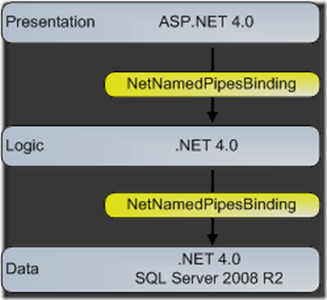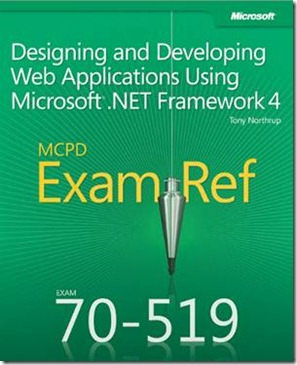RTM’d today: MCPD 70-519 Exam Ref: Designing and Developing Web Applications Using Microsoft .NET Framework 4
We’re happy to announce that MCPD 70-519 Exam Ref: Designing and Developing Web Applications Using Microsoft .NET Framework 4 (ISBN 9780735657267; 304 pages) shipped to the printer this week! This book is the first entry in the brand new Microsoft Press Exam Ref certification series.
Designed for experienced, MCTS-certified professionals ready to advance their status—this Exam Ref focuses on the critical-thinking and decision-making acumen needed for success at the MCPD level. The book provides a comprehensive and concise way of preparing for the MCPD 70-519 exam.
Each Exam Ref is organized by exam objectives for fast, efficient study, and includes the new Thought Experiment element. Thought Experiments help reinforce the design-level thinking required to master the exam and the job role.
Here’s an excerpt from the book’s introduction, along with a taste of the new Thought Experiment element from the book:
Introduction
Most development books take a very low-level approach, teaching you how to use individual classes and accomplish fine-grained tasks. Like the Microsoft 70-519 certification exam, this book takes a high-level approach, building on your lower-level web development knowledge and extending it into application design. Both the exam and the book are so high-level that there is very little coding involved. In fact, most of the code samples this book provides simply illustrate higher-level concepts.
The 70-519 certification exam tests your knowledge of designing and developing web applications. By passing the exam, you will prove that you have the knowledge and experience to design complex web applications using Microsoft technologies. This book will review every concept described in the exam objective domains:
· Design application architectures
· Design the user experience
· Design data strategies and structures
· Design a security architecture and implementation
· Prepare for and investigate application issues
· Design a deployment strategy
This book covers every exam objective, but it does not necessarily cover every exam question. Microsoft regularly adds new questions to the exam, making it impossible for this (or any) book to provide every answer. Instead, this book is designed to supplement your relevant independent study and real-world experience. If you encounter a topic in this book that you do not feel completely comfortable with, you should spend several hours researching the topic further using MSDN, blogs, and support forums. Ideally, you should also create a practical application with the technology to gain hands-on experience.
Thought Experiment: Planning for Scalability and Forward Compatibility
In the following thought experiment, you apply what you’ve learned about the Analyze Requirements And Recommend A System Topology objective to predict how a theoretical website architecture will perform. You can find answers to these questions in the “Answers” section at the end of this chapter.
You are a developer for Margie’s Travel, an Internet-based business that provides travel reviews and recommendations. Margie’s Travel has hired a developer to create an updated version of its website, and the company has asked you to review the design to verify that it meets its requirements for scalability and forward compatibility.
The new application is designed with a traditional three-tier architecture, as shown in Figure 1-6. Initially, all three layers will be implemented using a single server.

Figure 1-6 A three-tier application for Margie’s Travel
Management wants to verify that the design meets its requirements. Answer the following question about the future performance of the application:
1. What changes will the company need to make to the application if it moves each tier to its own server?
2. What changes will the company need to make to the logic tier if it wants to create a Windows Presentation Foundation (WPF) application as a secondary presentation interface?
3. What changes will the company need to make if it replaces SQL Server 2008 R2 with a non-Microsoft database server?
4. What changes will the company need to make if it replaces the ASP.NET presentation interface with a Linux presentation interface? What impact will that have?
5. The company expects the website to get about 200 visitors per day. Will a single dedicated server be fast enough?
Answers
1. The company will need to change from NetNamedPipesBinding (which only works between processes on a single server) to NetTcpBinding. If the developer stored the binding configuration in the .config files, this might only require updating the configuration files. If the developer hard-coded the bindings, that code will need to be edited, but it should be a simple change.
2. The company will need to add a secondary binding type to the logic tier, such as NetTcpBinding.
3. The company will need to change only the connection string for the data assembly.
4. The company will need to change the logic tier’s binding type to an open-standards based binding type, such as WsHttpBinding. It will have a minor, but perhaps not noticeable, negative impact on performance.
5. It’s impossible to say without testing the application to determine how many resources each request requires, how many requests each visitor makes, and how quickly visitors send requests at peak hours. However, most low-end servers can handle tens of thousands of visitors per day.
